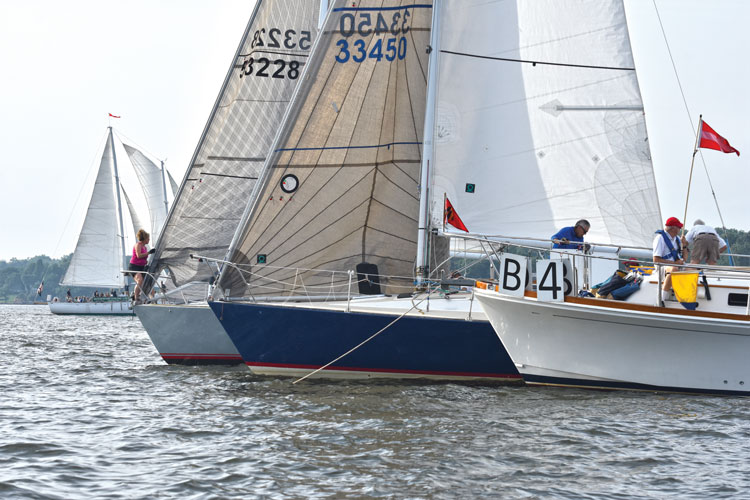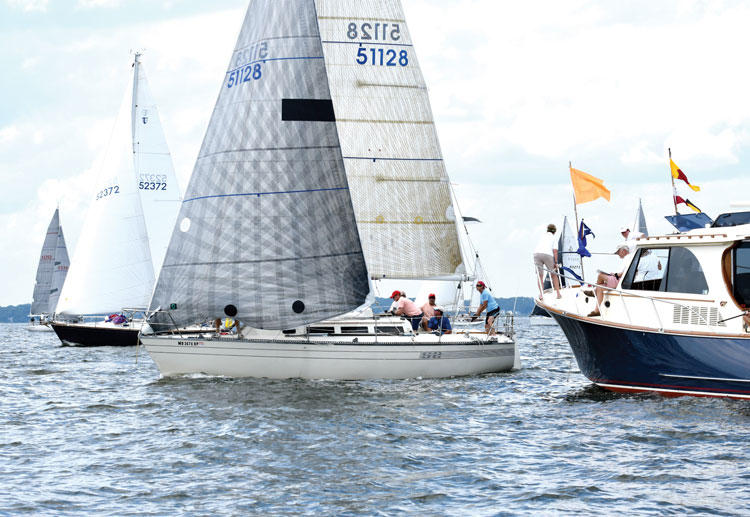Four Changes To Make During Mixed Fleet Racing
There have been reams of great stuff written on tactics and strategy for one-design racing. Classics from Stuart Walker, Dave Perry, Bill Gladstone, and others should form the basis of every racing sailor’s educational background. While many of these tried and true rules for racing in one-design fleets apply to those who are in mixed fleets (whatever the handicap rule), there are some notable exceptions. In some cases standard rules of thumb (cross when you can, stay up the middle, cover the fleet) need to be thrown out the window. Here are some thoughts on the changes you might need to make to survive the vagaries of mixed fleet racing.

Time is the competitor
The first thing to recognize is that you are racing the clock, not necessarily your competitors. Your goal is simply to get around the course as fast as possible. In one-design racing you don’t care how long it takes as long as you stay ahead of everyone else. This has a big impact. It means you need to minimize maneuvers. Every tack and gybe is a time loser, which also means that you probably won’t be sailing up the middle of the course but will need to aggressively pick a side. This is particularly true for the bigger and faster boats. You always need to extend. You can’t cover slower boats.
Starting
Speed, acceleration, and turning rate differentials coupled with overall upwind performance capabilities make starting in mixed fleets harder in many ways. The smallest slower boats typically are at the greatest disadvantage (another reason why you always want to be the scratch boat in your fleet whenever possible!). For the smaller and slower, classic conservative mid-line starts or somewhere in the third near the favored end, as we all have been taught, just may not work.
Get a good start in the middle and get rolled a minute later by some big beast that was three boat lengths late. If you are not faster, it is more critical to be at an end, and the weather end is safer. Starting to the right of most of the fleet will at least allow you to tack out and clear your air, even if it’s just a short hitch before tacking back to pursue your strategic plan to go straight off the starting line. Starting to the right of at least the bigger, faster boats is always a safe tactic.

One advantage for the smaller boats is maneuverability. Acceleration should also take less time. This means you can set up closer to the line than the big boys, making it easier to get an on-time front-row start. In starts where the committee boat is favored and you want to go right, if you can’t win the boat, it can actually pay to reach in from above the lay line a little late, accept a second row start, but immediately roll into a tack to clear air to head the way you want to go.
If the pin is favored heavily and all the boats are close to nose to tail when close hauled on starboard, you may be able to win the pin and survive. If the pin is only somewhat favored, a safer bet is to be comfortably to weather of the pack fighting for the perfect start.
For the big fast boat with better upwind capability it should be relatively easy to get a good start. The only challenge will be timing and not getting tied up with slower boats that have set up earlier and closer to the line. Bad air and traffic can keep you from getting the runway you need to build speed. Starting in a low-density area, probably toward the middle, will make the speed-time-distance equation easier.
If the line is heavily biased toward the committee boat, you can use your size and speed advantage to control the pack. Set up underneath the group at the RC boat, and sail high and slow to compress the group.
This allows you to bear off and pull the trigger when appropriate for your timing. All you need is a good sense of where the lay line is. Take a couple of practice runs to help figure this out and make sure you set up below, not above. Your height advantage will also make this group suffer in first minutes off the line. This is one of the few times you will be able to slow the rest of the fleet down and perhaps force them to go the wrong way.
Out on the course
The most important thing to remember is to not get mixed up with other boats. No luffing matches on the reaches! No need to hold a skinny lane upwind; take an extra boat length or two before you tack if another boat is on your air downwind. Gybe or head up to clear your air. If you have a close crossing, don’t chance it; duck the starboard tacker. Overstand a couple of lengths rather than trying to setup underneath a starboard tacker on the lay line. On a reach if a faster boat is coming up from behind, head up and get in a high lane well before they even get tempted to go over the top. Remember, you are racing the clock. Other boats are simply obstacles to avoid.
This may seem obvious, but for faster boats you need to make sure you know where you are going. There is no one to show you the way. Oh, there was a short and long windward mark and we just got a great start, blasted out, and rounded the mark intended for the smaller boats? Darn… Work hard on hitting perfect lay lines upwind and down so you can minimize maneuvers. Use a hand bearing compass and GPS to help.
Tactically, once clear of the mayhem of the start and the beginning of the first leg, slower boats finally have an advantage. Use the fast boats to help anticipate shifts and changes in velocity. The big guys are your telltales that will help take the guesswork out of what side of the course is working. The group from the right just crossed the leaders from the left by 10 boat lengths. That is a sign that it might be a good idea to go right. Downwind you can actually attack boats that are slightly faster, getting them set up in your wind shadow (point your windex at them), and slow them down.
Never slow down
In one-design boats the pressure is always on for speed. You have markers all around you that tell you if you are fast or slow, whether you are pointing well upwind or working low downwind. With boats of different sizes, speeds, and capabilities this immediate feedback is harder to get. You need good target speeds and angles to shoot for. Properly calibrated instruments are a big help. You can’t get lazy and assume that you are going fine. You have to constantly be moving the weight as appropriate and shifting gears with sail trim and steering. Every second gained could be the difference. Remember, it’s all about the clock. You should hear it ticking every moment, whipping and driving you until you finally cross the line and can relax.
Article By David Flynn of Quantum Sails




